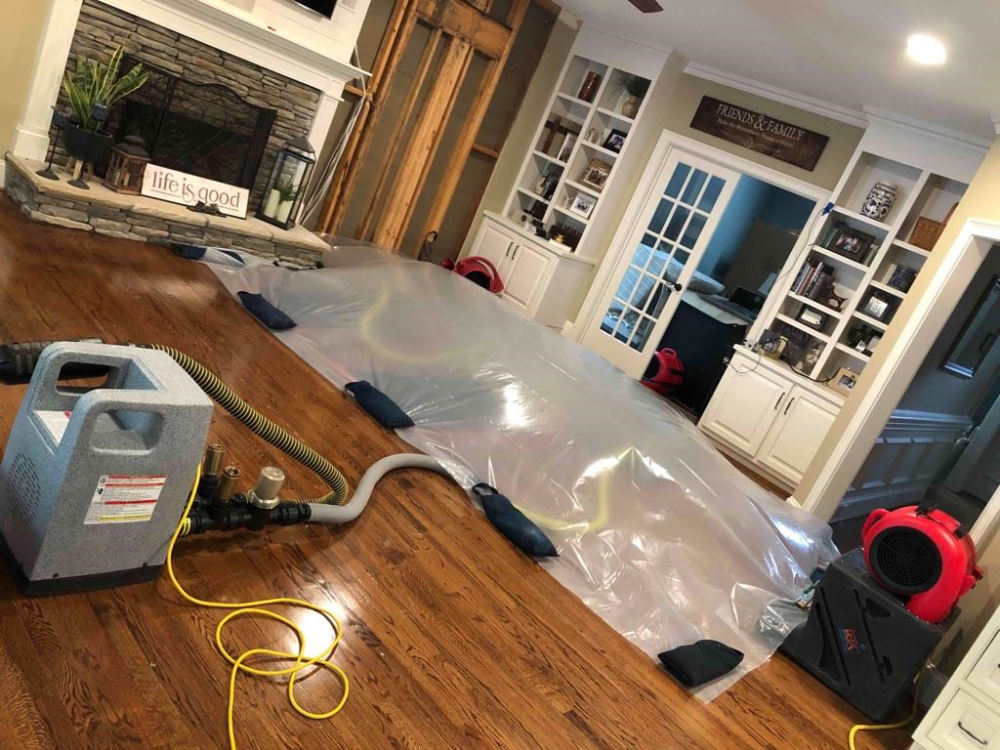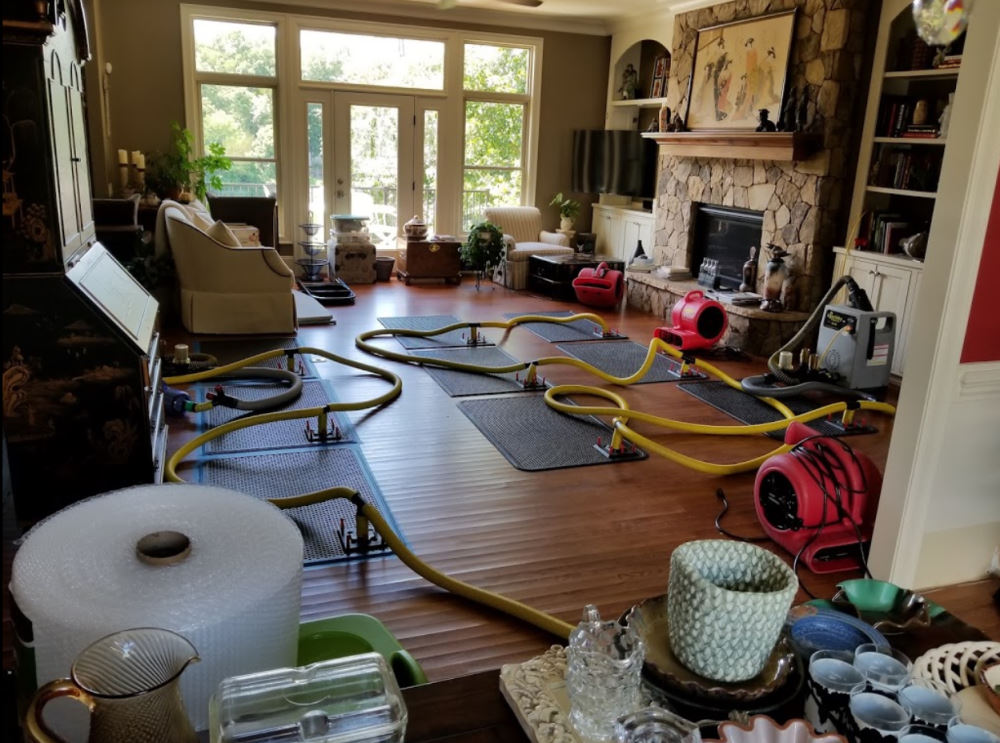Important Actions to Follow for Efficient Water Damage Repair in your house
When encountered with water damage in your home, understanding the important steps for effective repair can make all the distinction. You require to examine the damage and warranty security prior to dealing with the issue. Stopping the resource of water is essential, however it's simply the start. Once you have actually handled that, there's a series of actions you need to take to secure your building from additional concerns. Allow's explore what you need to do next.
Evaluate the Damage
When you find water damages in your home, the primary step is to evaluate the damages completely. Start by determining the resource of the water invasion. Look for leakages, burst pipes, or other concerns creating the problem. Next, analyze the influenced locations for noticeable signs of damage, including staining, mold, or warping development. Do not fail to remember to look in surprise spots like behind walls or under flooring, as water can leak into these areas unnoticed.Document the damage by taking clear images and notes. When talking about the situation with your insurance coverage provider or restoration professionals, this will help you. Take note of the sort of products impacted, as various materials call for various restoration strategies. Finally, review the extent of the damage. Is it comprehensive or minor? Recognizing the range will certainly assist you in deciding whether to manage it on your own or hire the experts for an extra extensive remediation process.

Ensure Safety
Prior to you begin any kind of reconstruction work, ensuring your safety is crucial. Analyze the problem of your home. If the water's deep or if you observe electrical hazards, do not enter the location. Shut off the electrical energy and gas supply to stop accidents. Put on protective equipment like gloves, masks, and boots to shield on your own from pollutants or mold.It's essential to remain knowledgeable about your environments; expect slippery surfaces and sharp things. Treat it as unsafe waste if the water is from a sewer back-up. Maintain kids and pet dogs away from affected locations to prevent exposure.Once you have actually taken these safety measures, you can wage the restoration process. Keep in mind, your security precedes, and if you're ever before unsure, it's finest to seek advice from a professional. Taking these actions will assist ensure you prepare to take on the restoration safely and efficiently.
Stop the Resource of Water
After ensuring your safety, the next action is to stop the resource of water. Identify where the leakage is originating from. It could be a burst pipeline, a malfunctioning appliance, and even heavy rainwater getting in with a harmed roofing. If it's a plumbing issue, switch off the main water supply to your home to avoid further flooding. For appliances, disconnect them and turn off their water valves.If the resource is outdoors, like rain, attempt to divert it far from your home making use of sandbags or other barriers. For small leakages, you could be able to make use of tape or a sealant momentarily until a specialist can fix it. Bear in mind, attending to the source swiftly is necessary to minimizing damage and preventing mold and mildew development. Once you've stopped the water, you'll remain in a far better setting to go on to the next action in the remediation procedure.

Get Rid Of Excess Water
Act rapidly to get rid of excess water, as standing water can cause much more comprehensive damages and mold and mildew growth. Collect your devices: a wet/dry vacuum cleaner, containers, and towels. If the water is superficial, you can use towels to saturate up the wetness. For much deeper water, a wet/dry vacuum cleaner is your best option. See to it to empty the vacuum regularly to stay clear of overflow.If the water is contaminated, like from a sewage back-up, use safety equipment, consisting of masks and gloves, to keep on your own secure. When you have actually removed as much water as feasible, inspect for concealed pockets of moisture in corners and under furnishings, as these can nurture mold.Don' t forget to turn off electric home appliances and power outlets in wet locations to stop dangers. This first action is crucial in lessening damage and establishing the stage for an effective repair process.
Dry and Dehumidify the Location
When you have actually Related Site eliminated the excess water, it's vital to completely dry and evaporate the location extensively. Begin by using dehumidifiers properly to pull wetness out of the air and avoid mold growth. Watch on humidity degrees to guarantee the room dries totally.
Remove Standing Water
To properly take on water damages, you need to concentrate on removing standing water as quickly as possible. Beginning by collecting necessary devices, like a wet/dry vacuum or a pump, relying on the volume of water. A vacuum needs to do the trick if the water is superficial. For larger quantities, a pump is extra efficient. While functioning, see to it to wear protective equipment to maintain on your own secure from pollutants. As you eliminate the water, pay focus to hidden locations like under furnishings or in corners where water could collect. When you've eliminated the majority, your room will certainly start to dry out. This step is essential, as lingering water can lead to mold development and more extensive damage.
Use Dehumidifiers Efficiently
Just how can you successfully use dehumidifiers to dry and dehumidify your area? Begin by positioning your dehumidifier in one of the most damaged location, preferably where water damage is most severe. Make certain to shut all doors and windows to develop a covered environment. Transform on the dehumidifier and set it to the ideal moisture degree, normally around 30-50%. Vacant the water collection storage tank frequently, or take into consideration utilizing a model with a continuous drainage alternative for comfort. Ideally, use followers to improve airflow, aiding the dehumidifier work extra efficiently. Maintain the dehumidifier running till you're certain that the location is extensively dried, protecting against mold and mildew development and added damages (Water Damage Restoration St George UT). This step is important for efficient water damages restoration
Screen Humidity Levels
Monitoring humidity levels is essential during the drying process, as it helps guarantee your space continues to be without excess dampness. Invest in a trustworthy hygrometer to track humidity precisely. Preferably, you intend to maintain degrees in between 30% and 50%. If humidity readings climb above this array, you may need to change your dehumidifiers or followers to boost air movement. Check the readings frequently, specifically in locations susceptible to wetness, like basements or washrooms. If you notice consistent high humidity, consider increasing air flow or making use of extra dehumidifiers. Remaining on top of these degrees not just speeds up the drying process but also protects against mold development, guaranteeing your home stays comfy and risk-free.
Clean and Disinfect Affected Surfaces

Recover and Fix Your Home
After cleaning and disinfecting the impacted areas, it's time to recover and fix your home. Begin by assessing the damages. Look for structural concerns, like damaged floors or walls, and attend to any type of essential repairs. Changing harmed drywall navigate to this website or flooring is essential for both aesthetic appeals and safety.If your furnishings or items were affected, consider whether they can be salvaged or need replacement. Tidy or professionally restore items where possible.Next, repaint walls and touch up any type of areas that need focus. This not only enhances look however additionally secures surface areas internet from future water damage.Don' t fail to remember to check your plumbing and appliances for leaks, making certain everything's operating effectively. Lastly, think about setting up a dehumidifier to stop future dampness problems. By taking these steps, you'll restore your home to its former splendor and produce a much safer living setting.
Frequently Asked Concerns
How Long Does Water Damage Restoration Generally Take?
Water damages reconstruction typically takes anywhere from a few days to a number of weeks, relying on the extent of the damages (Water Damage Repair). You'll desire to examine the circumstance quickly to reduce more complications and guarantee appropriate remediation
Will My Insurance Coverage Cover Water Damage Reconstruction Prices?
Your insurance coverage could cover water damages reconstruction expenses, but it relies on your plan. Check your coverage information and contact your insurance coverage agent to clarify what's consisted of and what you require to submit an insurance claim.
Can I Deal With Water Damages Remediation Myself?
You can handle water damage repair yourself, however it's crucial to assess the scenario. If it's considerable, you might intend to call specialists. Always focus on safety and assure you've got the right tools.
What Are the Signs of Hidden Water Damage?
You may discover indicators of surprise water damages like distorted wall surfaces, musty odors, or staining. If your floors really feel squishy or you area mold and mildew, it's time to check out even more before the circumstance intensifies.
Just How Can I Avoid Future Water Damages in My Home?
To avoid future water damages in your house, you need to frequently examine pipes, seal fractures, preserve gutters, and guarantee proper drainage. Setting up a sump pump and wetness barriers can also aid maintain your room dry. When you find water damage in your home, the first step is to analyze the damages completely. Act swiftly to eliminate excess water, as standing water can lead to much more substantial damage and mold development. To properly deal with water damage, you require to concentrate on getting rid of standing water as rapidly as feasible. As you remove the water, pay focus to hidden locations like under furniture or in edges where water may gather. Water damage remediation generally takes anywhere from a few days to a number of weeks, depending on the extent of the damages.